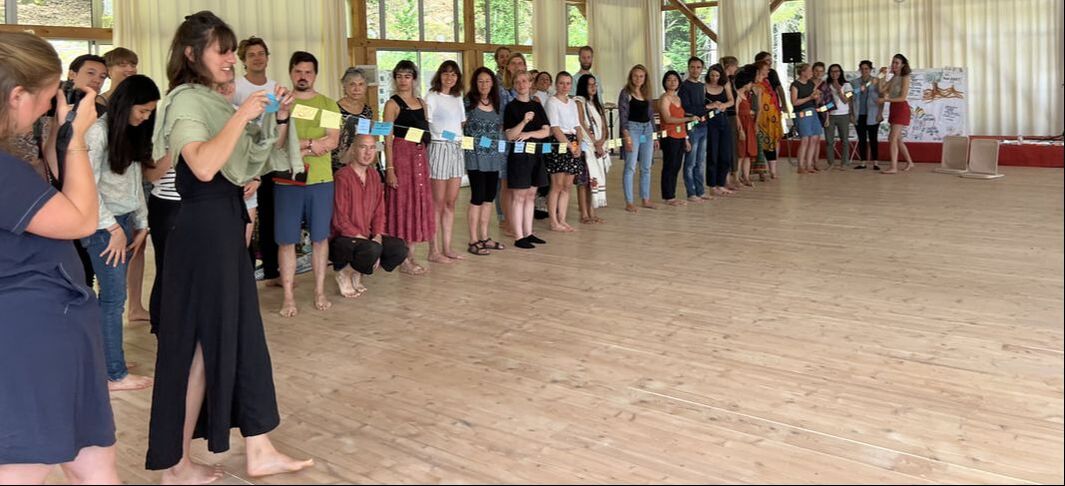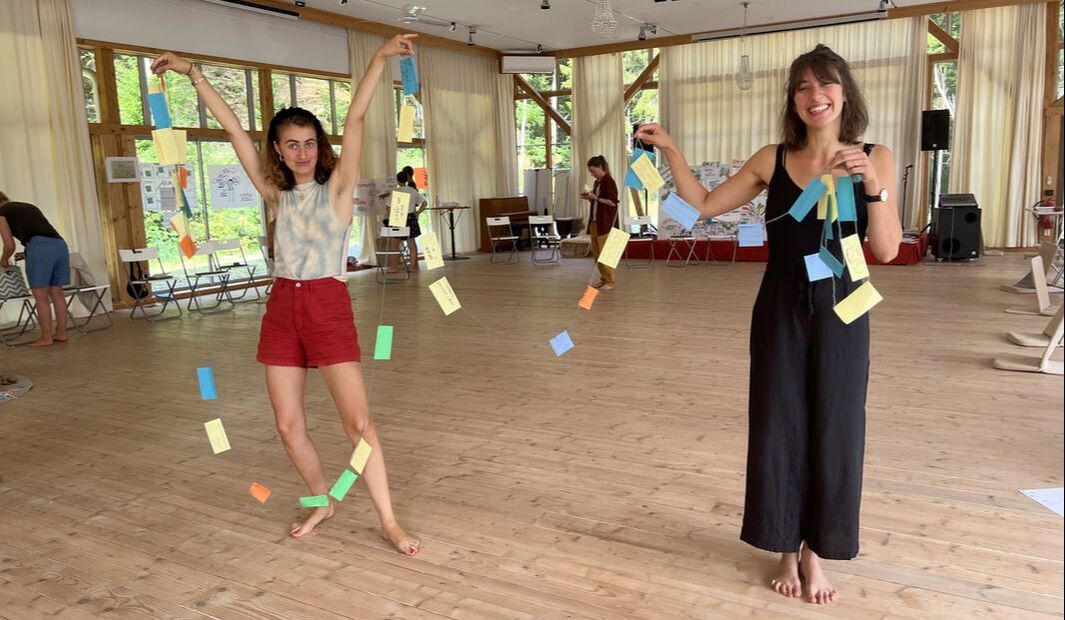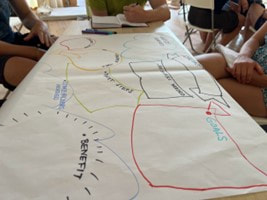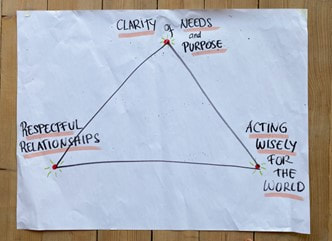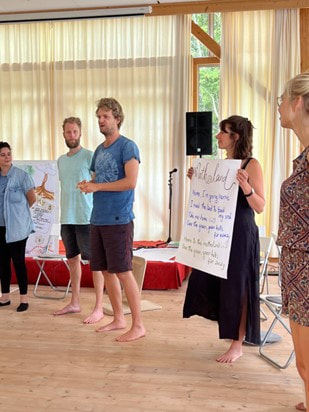Flow
|
Story of Day 3
|
The meta harvest flowed from the check in, weaving an overarching narrative of the learnings of the week. After walking through the agenda of the past days, in small groups we engaged in dialogue and then wrote down three key essences as answers to the question “ What are moments when you experienced us bridging divides?”
Post-its in hand, we were ushered to the side of the room, sun spilling in from the windows. One by one we stepped forward to create a physical line behind a horizontal line of string where our post-its were hung, one by one, like a clothesline.
We witnessed the person walk, watched as they attached the note to the string and stepped back next to another, waiting for the next, until the line stretched from one wall to another. A visually stunning representation of our insights in relation to the calling question, created by individual and collective intelligence, not only readable in note form but visible as one-sentence sparks of clarity.
Post-its in hand, we were ushered to the side of the room, sun spilling in from the windows. One by one we stepped forward to create a physical line behind a horizontal line of string where our post-its were hung, one by one, like a clothesline.
We witnessed the person walk, watched as they attached the note to the string and stepped back next to another, waiting for the next, until the line stretched from one wall to another. A visually stunning representation of our insights in relation to the calling question, created by individual and collective intelligence, not only readable in note form but visible as one-sentence sparks of clarity.
To be prepared to dive into design for wiser action, a process model for prototyping real projects and gaining wisdom into a longer work of planning, Steph and Isabel explained the principle of The 7 little helpers, and the design tool The Chaordic Path.
The Charodic Stepping Stones include questions around need, purpose, principles, people, concept, limiting beliefs, structure, practice and harvest. Often when we begin projects we immediately start with a concept - what do we want to do? For example, we want to organize a conference. However, to dive more deeply into designing from need and designing from harvest, otherwise known as designing from strategic outcomes, we need to first consider why we are doing this work. By beginning with need and purpose, considering the team of people that is needed and our principles for working together before looking at concepts, we can build more client and need centered designs for social processes.
The Charodic Stepping Stones include questions around need, purpose, principles, people, concept, limiting beliefs, structure, practice and harvest. Often when we begin projects we immediately start with a concept - what do we want to do? For example, we want to organize a conference. However, to dive more deeply into designing from need and designing from harvest, otherwise known as designing from strategic outcomes, we need to first consider why we are doing this work. By beginning with need and purpose, considering the team of people that is needed and our principles for working together before looking at concepts, we can build more client and need centered designs for social processes.
After landing on a concept, we quite often just begin. But have we considered the barriers, whether internal or external, that are obstacles to our work? Limiting beliefs allows groups to safely explore that which might hinder our work before it even begins. Often limiting beliefs arise whether or not they are worked with in the team, whether they lie within each person or in the larger stakeholder group. There are many ways to work with limiting beliefs and it is crucial that the process is designed to match and serve the team, However, by including them as a “stone” or area within a larger planning process it creates an opening into these kinds of conversations.
Each stone has its own unique importance, trajectory, and challenges depending on the project. They can be worked with over time, revised and revised along the way, or can serve as an overarching strategic planning narrative that teams can come back to. Sometimes smaller groups or teams can take responsibility for ensuring one of the stones is carrier through the project.
Each stone has its own unique importance, trajectory, and challenges depending on the project. They can be worked with over time, revised and revised along the way, or can serve as an overarching strategic planning narrative that teams can come back to. Sometimes smaller groups or teams can take responsibility for ensuring one of the stones is carrier through the project.
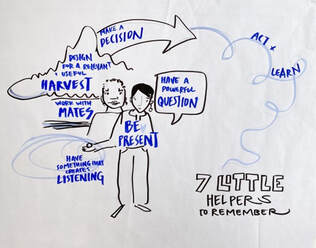
The seven little helpers are a quick checklist to remember when stepping into hosting. They are: Be Present; Have something that creates listening (any method); Have a good question (related to the purpose); Work with mates (check in with your team, even when facilitating alone); Harvest something (show your results to build accountability); Make a decision (decide on an end point or next steps before the session is done); Act and Learn ( every ending is a beginning. All aspects are important in process design and provide practitioners with a quick check list before stepping into a meeting.
We also reminded participants of the design from harvest template they had used throughout the week to underline the importance of working from need and purpose with powerful questions towards both tangible and intangible harvest.
Hosted by a team of participants, we were swiftly guided through the multi-step process of design for wiser action - with focus and ease.
Hosted by a team of participants, we were swiftly guided through the multi-step process of design for wiser action - with focus and ease.
The project callers invited us into action around six different projects:
Moving through different rounds, we discussed
We heard the project callers share their gratitudes and next steps. After a short break we returned to smaller circles of eight, sharing on the name question before spiraling into the whole group to reflect on the same question. We thanked each other, verbally and non verbally, ending as we had begun by taking one step into the circle.
- Working between different stakeholders with human rights in factories in Vietnam (Nguyễn)
- Engaging in Black Lives Matter dialogues and policy in the Netherlands (Sara)
- Farm to Food Climate Festival in Germany (Amelie)
- Visioning for intentional communities in Denmark (Camilla and Mads)
- Photo Journaling Sustainability and Community Engagement in Sweden (Pear)
- Empowering youth business leaders in Indonesia (Dinye)
Moving through different rounds, we discussed
- Foundational questions related to the project and its narrative from the core group of supportive participants.
- What is missing/needs clarity (with a no-response feedback round from a new group)
- Refinements to the project and next steps with the core group
We heard the project callers share their gratitudes and next steps. After a short break we returned to smaller circles of eight, sharing on the name question before spiraling into the whole group to reflect on the same question. We thanked each other, verbally and non verbally, ending as we had begun by taking one step into the circle.
|
Mansi and Isabel welcomed us into the Art of Hosting Community energetically and practically by offering stories, platforms, and groups. We closed in song, finding our way through a new harmony of home. Home I’m going home, I need a land to heal my soul. Take me home, take me home Over the green green fields and far away. Home to motherland, home to the motherland, home to the motherland over the green green fields and far away… |
After that it was all about goodbyes, hugs, exchanging contact info and “see you again” - a wonderful closure to our 4 amazing days together at Mundekulla, Sweden.
